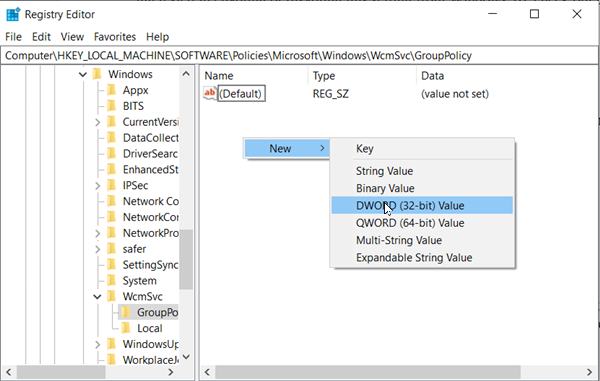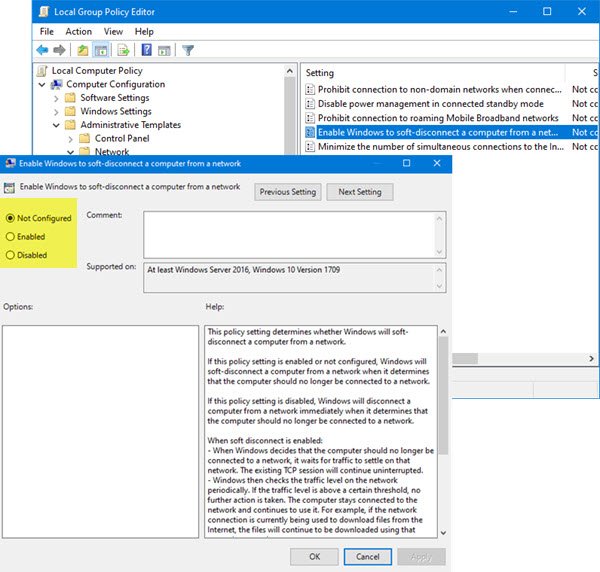In a move to make Windows computers notify an application to stop using a specific network interface, a new Group Policy setting is available. It is called Enable Windows to soft-disconnect a computer from a network. The setting determines how Windows should disconnect a computer from a network when it finds it is no longer connected. So, if you want to enable or disable this setting from Windows 11/10, this post will help you.
What is Soft Disconnect in Windows?
When the setting is enabled, Windows will soft-disconnect a computer from a network, not immediately or abruptly. In contrast, if the setting is disabled, Windows will immediately disconnect a computer or a PC from a network.
In simple words, instead of an immediate disconnect, Windows, when it knows that the network is not working or the internet connection is not working anymore, it notifies the program that it has to wrap up. So, if a program is downloading a game, it can make arrangements that allow it to restart when the network is back.
Enable Windows to Soft Disconnect a computer from a Network
You have two ways to configure Soft Disconnect a computer from a Network in Windows 11/10
- Tweaking the Registry Setting
- Changing the Group Policy setting
Please note that the default behavior is soft-disconnect if the setting is not configured.
1] Tweaking the Registry Setting
It comes in handy when changing the policy on multiple computers. You can create the registry and then apply it to all the PCs.
- Press Win+R in combination to bring up the ‘Run’ dialog box.
- In the empty field of the box, type ‘regedit’ and hit the ‘Enter’ key.
- When the Registry Editor opens, navigate to the following path address –
HKEY_LOCAL_MACHINE\Software\Policies\Microsoft\Windows\WcmSvc\GroupPolicy
- If you do find such an entry, then create the registry key.

- Now, create a new 32-bit DWORD value SoftDisconnectConnections and configure its value as follows:
- 0 = Disable Soft Disconnect
- 1 = Enable Soft Disconnect

You can delete the SoftDisconnectConnections value to restore the system defaults. When you’re done, close the Registry Editor and restart your computer to allow the changes to take effect.
2] Changing the Group Policy Setting
Those using Windows Pro and the above version can use the Group Policy editor to make the changes.
- To open the group policy editor, type gpedit.msc in the run box and press Enter.
- Next, navigate to the following folder in the Group Policy
Computer Configuration > Administrative Templates > Network > Windows Connection Manager
- Double-click the Enable Windows to soft-disconnect a computer from a network policy.

- To disable the feature, set the policy to Disabled. You can also leave it as’ Not configured’ or set it to Enabled.
Policy Details for Soft-disconnect on Windows
This policy setting determines whether Windows will soft-disconnect a computer from a network.
If this policy setting is enabled or not configured, Windows will soft-disconnect a computer from a network when it determines that the computer should no longer be connected to a network.
If this policy setting is disabled, Windows will disconnect a computer from a network immediately when it determines that the computer should no longer be connected to a network.
When soft disconnect is enabled:
- When Windows decides that the computer should no longer be connected to a network, it waits for traffic to settle on that network. The existing TCP session will continue uninterrupted.
- Windows then checks the traffic level on the network periodically. If the traffic level is above a certain threshold, no further action is taken. The computer stays connected to the network and continues to use it. For example, if the network connection is currently being used to download files from the Internet, the files will continue to be downloaded using that network connection.
- When the network traffic drops below this threshold, the computer will be disconnected from the network. Apps that keep a network connection active even when they’re not actively using it (for example, email apps) might lose their connection. If this happens, these apps should re-establish their connection over a different network.
This policy setting depends on other group policy settings. For example, if ‘Minimize the number of simultaneous connections to the Internet or a Windows Domain’ is disabled, Windows will not disconnect from any networks.
Disabling soft disconnect policy is mainly used for specific troubleshooting or high-security situations. However, for most workplaces and individual users, enabling soft disconnect is recommended for a smoother and less disruptive experience—more on the official page.
What is the effect of soft disconnect on VoIP?
When a user is on a VoIP call over a mobile broadband network and their laptop is connected to a corporate Ethernet, the call may be lost. However, with the right app and policy in place, the connection can be recovered automatically over the new network. If the policy is not enabled, Windows will instead wait for the call to complete and then soft-disconnect the mobile broadband connection.
How does Windows prioritize connections?
Your PC prioritizes wired connections for speed. You can also connect to Wi-Fi or other networks on the fly. A strong Wi-Fi signal means a smoother connection. For Wi-Fi priority, you can set a preferred list. While signal strength matters, Windows doesn’t pick based on current internet speed. You can still tweak settings to influence which network gets used.